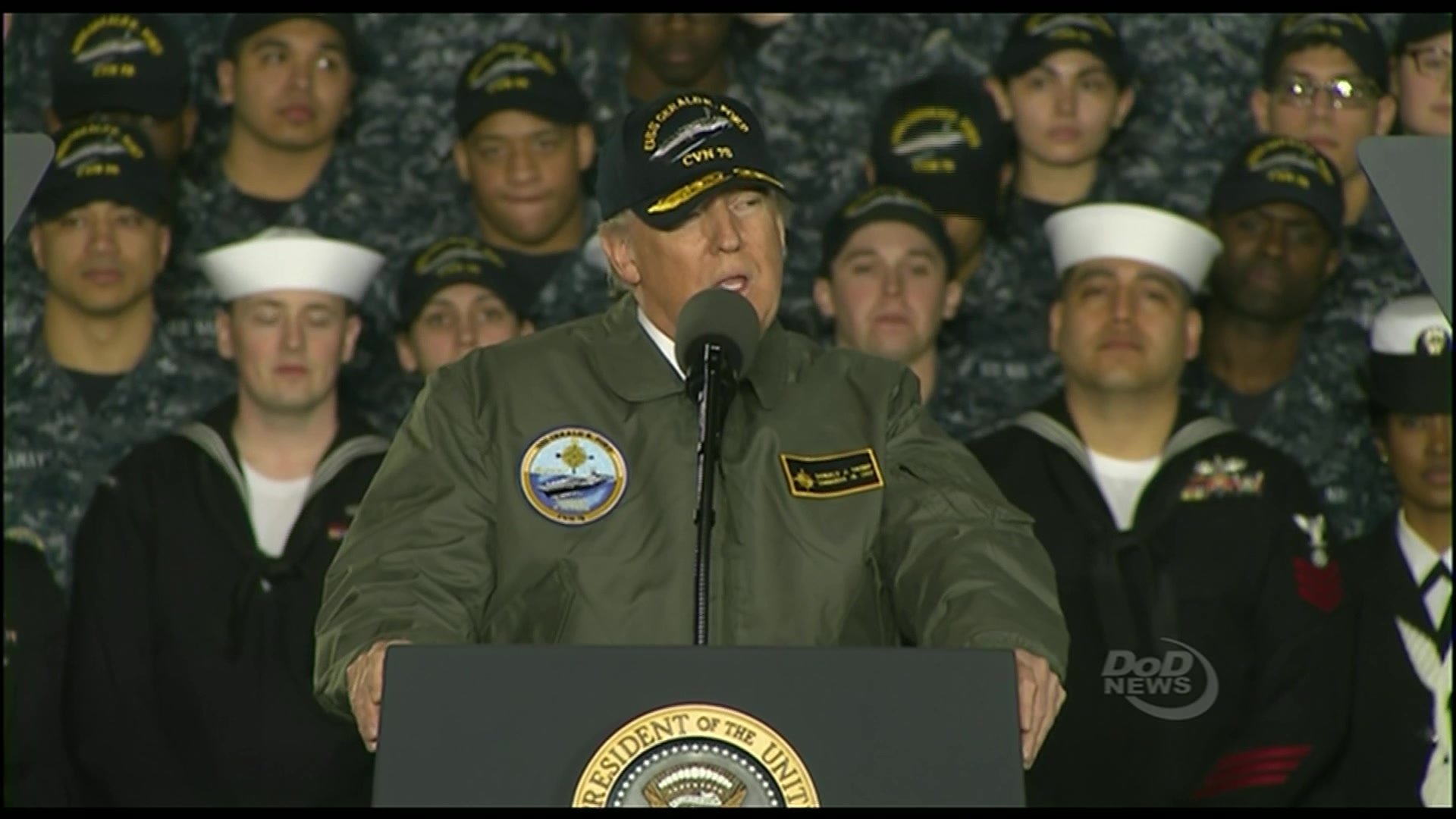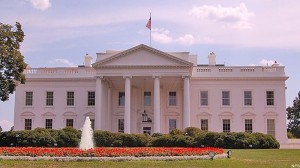Trump’s Promised Big Boost To DoD Evaporates In 2018 Budget
Posted on
 Campaign promises of a larger, more ready and fully modernized military have slammed into budget realities as the Trump administration’s fiscal 2018 budget for the Pentagon shows only modest growth above what the Obama administration had projected.
Campaign promises of a larger, more ready and fully modernized military have slammed into budget realities as the Trump administration’s fiscal 2018 budget for the Pentagon shows only modest growth above what the Obama administration had projected.
Funding at those levels will support a 305-ship Navy, not the 350 ships that candidate Trump proposed back in September; an Army of 476,000, not the 540,000 proposed, and an Air Force forced to choose between modernization and size. To be fair, the Trump administration said that this was not a “policy” budget projection but could be reconsidered in light of the strategy review now going on. However, the facts on the ground are set, and Defense Secretary Jim Mattis will be hard-pressed to change them.

President Trump and Defense Secretary Jim Mattis
The Trump administration projection for the defense budget takes the fiscal 2018 level and simply pushes it into the future, assuming it grows at the rate of inflation. Back in March, the administration described the 2018 level as “an increase of $54 billion,” but that was using the Budget Control Act/“sequestration” level as a baseline. It was only $18 billion above what DoD already expected to get, as budget analysts pointed out at the time. This certainly is not the Reagan-esque budget increase that many had hoped for, although there had been forebodings for many months that the actual increase might be limited.
About half of the proposed increase will be consumed by “must pay bills” such as pay raises and funds for management savings like healthcare fees and reduced housing allowances that Congress did not enact. There is just not much money left over to buy additional program.
The Center for Strategic and International Studies (CSIS, where Cancian works) has a Force Cost Calculator that connects budgets with forces, readiness, and modernization programs, so we can see what the administration’s budget could support. Bottom line: The services face difficult trade-offs among force size, readiness, and modernization.
Under the administration’s top line, the Navy could grow to about 305 ships, which is larger than it is today (290) and about where the Obama administration projected it would rise to, but far below the 350 ships the Trump administration and many others have talked about, let alone the 355 ships the Navy says it needs. The Navy could buy some additional readiness at this budget level, but not much. If it wanted to fully fix the readiness problems that it has identified, then the long term fleet size would drop to about 295.
The Army could maintain the 476,000 active duty end strength that Congress has set for it and buy back some lost readiness, but it could not expand its anemic long term modernization program. People are expensive and supporting that end strength would crowd out other investments. If the Army fully fixed its readiness and expanded its modernization program, then the active duty end strength would drop to 450,000. But that’s the Obama level that the Army and many observers had denounced as too low. Given the increasing demands for ground forces in Europe, Iraq, and Afghanistan, they are probably right.
The Air Force wants to increase readiness and accelerate modernization by buying F-35s, KC-46s, and F-22 upgrades and launching new programs like the B-21 bomber and the GBSD missile (replacement for the Minuteman III). It is also under pressure to maintain legacy aircraft like the F-16s, F-15s, and A-10s so it has enough forces to cover all of the demands put on it. If the Air Force wanted to accelerate its modernization programs under the administration’s budget level, it would need to cut about 100 legacy fourth-generation aircraft, for example, retiring the A-10 fleet (and KC-10 tanker fleet). If it wanted to both accelerate modernization and fully fund readiness, it would have to retire the F-15 fleet also and some F-16s. That would entail a bruising battle with its reserve components and with close air support advocates.
The Marine Corps could achieve its target of 186,000 personnel and increase its readiness, but would not be able to expand its ground modernization program.

B-21 artist rendering
One bright spot in the Trump budget would be strategic nuclear forces. The proposed budget could fully fund nuclear modernization, accelerate the Columbia-class SSBNs and B-21 bombers, and substantially expand missile defense.
Let’s consider the trade-offs the Trump White House have to make to achieve its stated goals to provide some perspective. What if the administration wanted to build a 350-ship Navy, even at the expense of the other services? It could do that, but paying for it would drive the Army down to 420,000 active-duty soldiers.
Suppose the administration wanted to build up the Army to increase the potential for boots on the ground and in recognition of the continuing wars in Iraq and Afghanistan? It could expand the Army to the Army’s desired strength of about 505,000 active-duty soldiers, but that would drive the Navy down to 270 ships and 10 carriers.
- This is a far cry from Sen. McCain’s proposed national security budget of $640 billion ($610 billion for DOD). That budget does it all:
- Builds an Army of 500,000 active-duty soldiers, a Navy on track to 350 ships, and Air Force with 1,500 combat coded fighters and a robust modern position program, a Marine Corps of 200,000.
- Greatly increases readiness funding to fix the shortfalls identified by the service chiefs
- Fully funds modernization programs, and
- Establishes several funds for innovation so that future forces would not look the same as past forces.
The Pentagon’s recently launched strategy review has its work cut out for it. Instead of making large increases in many areas, it can only make a few, highly targeted increases and must hold the line elsewhere. This may be a particular challenge for Mattis, who has extensive experience with current military operations and with thinking about the future of conflict, but not much with programs and budgets, never having been a service chief.
 As DoD goes through its analysis, it will find that there is too much of a gap between what the emerging strategy is demanding—increased operations in Iraq and Afghanistan, plus no slow down of operations in Europe or the Western Pacific—and the resources that the Office of Management and Budget (OMB) has made available. Mattis will almost certainly go back to the White House during the summer to get more money. The budget documents say this is a possibility. That will require a fight with OMB, which is struggling with higher deficits from proposed tax cuts and failed reductions to domestic programs.
As DoD goes through its analysis, it will find that there is too much of a gap between what the emerging strategy is demanding—increased operations in Iraq and Afghanistan, plus no slow down of operations in Europe or the Western Pacific—and the resources that the Office of Management and Budget (OMB) has made available. Mattis will almost certainly go back to the White House during the summer to get more money. The budget documents say this is a possibility. That will require a fight with OMB, which is struggling with higher deficits from proposed tax cuts and failed reductions to domestic programs.
Even the administration’s modest fiscal 2018 budget increase is not a sure thing because it has to get through a stalemated Congress. The administration got only half of its proposed fiscal 2017 $30 billion increase and that required pushing more base funds into the war funding, “OCO”, to get around budget caps.
This is something OMB director Mick Mulvaney had railed against when he was a congressman, but where you stand depends on where you sit. OCO is the grease that allows budget deals to operate smoothly, even if that circumvents regular budgeting practices, and Mulvaney may come to rely on it just as his predecessors did.
Subscribe to our newsletter
Promotions, new products and sales. Directly to your inbox.
